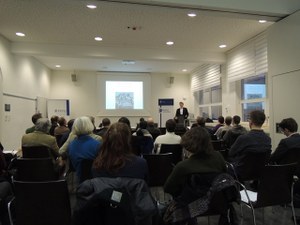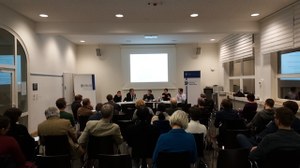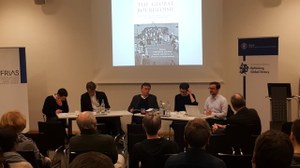A New Approach to History: Looking back at the Inauguration of the Balzan FRIAS-Project in Global History
It is no easy task to explain what global history is. During the symposium, which marked the inauguration of the Balzan FRIAS-Project in Global History, Professor Jürgen Osterhammel applied a definition ex negativo: According to the Distinguished FRIAS Fellow and leader of the project, global history is not about writing a universal history of the world. Neither does it aim at tracing different longue durées, as it was previously done by the Annales school in the 20th century. To Osterhammel global history is rather “a type of historiography that considers global effects, that is thought from the periphery and that takes cosmopolitan mindsets into account. But above all, it provides a perspective, a laboratory, in which familiar topics can be reconsidered from a global view.”
With this inter- and transdisciplinary perspective Osterhammel’s Balzan-Pproject in Global History is a perfect fit for FRIAS’ research profile, as FRIAS director Bernd Kortmann emphasized at the beginning of the symposium: “In the months to follow, global aspects will be of ever-growing importance to FRIAS. Our current research focus ‘Environmental Forecasting’, which focuses on climate change as a phenomenon relevant to the global community and which will be superseded by the focus “Environmental Humanities” next year, is only one example. Cooperations with international partners, for example within the Human Rights Research Consortium and with our partner institute MIASA in Accra, also speak of the importance of a global perspective. We are very proud to have the Balzan-FRIAS project complementing this spectrum.
Global History and Social History - a Contradiction?
 With the volume The Global Bourgeoisie: The Rise of the Middle Classes in the Age of Empire (Princeton University Press 2019), Jürgen Osterhammel took a shot at rewriting the history of a social phenomenon from a global perspective: the middle classes or, as it is called in Marxist theory, ‘Bourgeoisie’. Together with his co-editors, the historians Christof Dejung, Professor at the University of Bern, and David Motadel, Professor at the London School of Economics and Political Science, and thirteen authors tried to adopt methods from global and social history.
With the volume The Global Bourgeoisie: The Rise of the Middle Classes in the Age of Empire (Princeton University Press 2019), Jürgen Osterhammel took a shot at rewriting the history of a social phenomenon from a global perspective: the middle classes or, as it is called in Marxist theory, ‘Bourgeoisie’. Together with his co-editors, the historians Christof Dejung, Professor at the University of Bern, and David Motadel, Professor at the London School of Economics and Political Science, and thirteen authors tried to adopt methods from global and social history.
During the symposium, Christof Dejung raised the question of what challenges arise when social and global history are brought together. Unlike the title of the symposium suggested, Dejung did not consider both approaches irreconcilable. To transfer seemingly universal social categories such as class to other cultures, however, poses, by all means, certain risks, as he stressed: “One should ask beforehand to what extent such terminologies are applicable to different cultures and eras. Researchers are quick to operate with a consistent terminology, but if this is done without reflection, a distorted picture might be the result.”
The value of a combined approach of social and global history can be seen from the example of the textile industry. In the era of industrialization, a network of relationships emerged whose effects were felt all over the world in a similar way: “Large factories were built in Manchester and Milan, raw materials were brought in from the colonies. The capitalist structures that formed in the process were the same everywhere: work force on the one hand, capital on the other.” As Dejung explains, global processes of entanglement and intertwining have always offered a rich field of research for him and his co-editors. Dejung himself analyzed the international networks of Swiss businessmen in the 19th and 20th century, David Motadel studied the visits to Europe of the Persian shahs. “To think only locally won’t suffice in these cases.”
David Motadel explained how the editors of “The Global Bourgeoisie” approached the complex experiment global history. While many contributors chose a comparative perspective and analyzed single aspects in their global implications, others provided case studies of single states and regions. The editors led the way by assembling topics under categories such as “State and Class”, “Capitalism and Class”, or “Religion and the Betterment of the world”. A comprehensive introduction by the editors and a review by the renowned London historian Richard Drayton strived to synthesize the results.
 |  |
|---|
Chances and Risks of a Global Historiography
In the following panel discussion, the volume itself became an object of study. Together with Islam scholar and FRIAS fellow Dr. Simon Wolfgang Fuchs, and Stefanie Gänger, Professor of Modern History at the University of Heidelberg and co-leader of the Balzan-FRIAS project, the editors discussed pitfalls and chances of a global historiography.
Gänger appreciated the method of proceeding according to thematic complexes and to connect these single studies on various cultures to an overall picture. However, she considered it as a general difficulty that this approach tends to offer a fragmentary view and often overemphasizes similarities. How similar the middle classes all over the world became was demonstrated by the editors: Nobody knew the right answer to the question where the picture was taken that serves now as the volume’s cover. It’s not Brighton or resort at the Baltic Sea that provided the scenery as the audience speculated, but a hotel in Montevideo: It wouldn’t be possible to judge from clothing or architecture.
According to Simon Wolfgang Fuchs, such superficial similarities can pose a threat and obstruct a clear view. Especially the assumption that a cosmopolitan way of thinking and a firm belief in progress and education are defining features of the middle class occasionally turns out to be a fallacy. Fuchs offered a revealing counterexample: “In the Osman Empire, it was not members of the middle classes but of the minorities who served as brokers: They were globally connected and had the best education.”
In spite of all risks, the experiment “global history” is worth the effort. The relevance of the project is obvious: Tendencies to populism, mistrust against the political elites and the ever-increasing angst of the middle classes can be observed worldwide and traced back to the same or at least quite similar roots. This enedeavor is necessarily an experiment, but it is, as David Motadel confirms, fun, too.
Photographs: Max Brandl
Text: Verena Spohn

